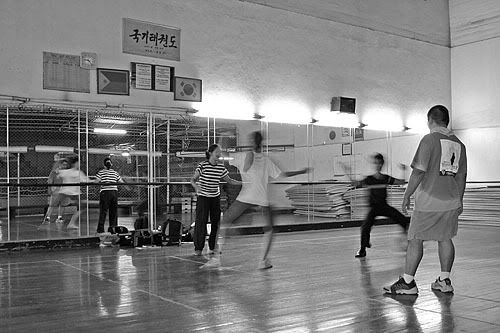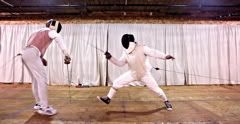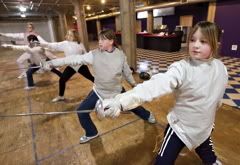wow cool.. you started already.. ehhe hope to see you guyz this month!
Results 31 to 40 of 52
-
03-05-2007, 01:56 PM #31Banned User

- Join Date
- Feb 2006
- Gender

- Posts
- 915
 Re: ~theatrical fencing & stage combat~
Re: ~theatrical fencing & stage combat~
-
03-05-2007, 02:15 PM #32Junior Member

- Join Date
- Jan 2007
- Posts
- 212
 Re: ~theatrical fencing & stage combat~
Re: ~theatrical fencing & stage combat~
wow.,.. nice ni dah...

-
03-16-2007, 03:00 AM #33

- Join Date
- May 2003
- Gender

- Posts
- 2,672
 Re: ~theatrical fencing & stage combat~
Re: ~theatrical fencing & stage combat~

an excercise in distance where fencers practice footwork while keeping points together
-
03-17-2007, 12:43 PM #34
 Re: ~theatrical fencing & stage combat~
Re: ~theatrical fencing & stage combat~
pila sad ka oras kada session?
-
03-18-2007, 01:45 PM #35

- Join Date
- May 2003
- Gender

- Posts
- 2,672
 Re: ~theatrical fencing & stage combat~
Re: ~theatrical fencing & stage combat~
2~3 hours
last orientation for the first batch in the basic training program is this thursday March 22
-
03-21-2007, 11:57 AM #36

- Join Date
- May 2003
- Gender

- Posts
- 2,672
 Re: ~theatrical fencing & stage combat~ final orientation and sign up March 22
Re: ~theatrical fencing & stage combat~ final orientation and sign up March 22
footwork exercise in speed

fencers take turns trying to tag their partner
-
03-21-2007, 09:56 PM #37Junior Member

- Join Date
- Oct 2006
- Posts
- 423
 Re: ~theatrical fencing & stage combat~ final orientation and sign up March 22
Re: ~theatrical fencing & stage combat~ final orientation and sign up March 22
This is nice. :mrgreen: Can my hubby join?
I'd like to point out that Viggo Mortensen's Aragorn character is not fencing but using a sword. Nevertheless, this is a really good idea. I like to try arnis though...anything that uses double sword, or knife or wood. Basta double.
-
03-21-2007, 10:56 PM #38

- Join Date
- May 2003
- Gender

- Posts
- 2,672
 Re: ~theatrical fencing & stage combat~ final orientation and sign up March 22
Re: ~theatrical fencing & stage combat~ final orientation and sign up March 22
Hi zahara... Well, um.... actually, by definition, when a sword is used for both offence and defence it is technically fencing.
even kendo is refered as "japanese fencing". Aside from that... if fencing doesn't use swords then what do we use
This thread is about theatrical fencing and stage combat... so after our members are grounded in fencing those who would
like to do theatrical work will start exploring other sword fighting styles... ala Swordplay Studios in California:
www.swordplaystudios.com
By the way, the sword master for the LOTR trilogy was Bob Anderson who is a fencer. He played in the Olympics for
England before starting a career in film helping the great Errol Flynn in his swordfighting scenes and has began training
actors and stuntman from then on up to Viggo Mortensen and the rest of LOTR cast. His other most recent works
was sword master for "Pirates of the Caribbean: The Curse of the Black Pearl" and "The Legend of Zorro"
You've also seen him in action as the fight double for the light saber duels of Darth Vader in "The Empire Strikes Back"
and "Return of the Jedi" :mrgreen:
You and you're husband are welcome to join us. We meet Thursday nights 7pm at Baseline
-
03-24-2007, 12:20 AM #39

- Join Date
- May 2003
- Gender

- Posts
- 2,672
 Re: ~theatrical fencing & stage combat~ final orientation and sign up March 22
Re: ~theatrical fencing & stage combat~ final orientation and sign up March 22
Fascination With Fencing
by
Heide B. Malhotra, Epoch Times Washington, D.C., Staff
My first exposure to fencing was as a child fascinated by the scars on
the face of a family friend. I still remember sitting on his knees and
hearing him tell me in simple language the story of his student fencing
days as a member in a dueling fraternity.
He told me how he got the scar and that he put vinegar on it so he would
carry the scar as symbol of his fraternity dueling days. I am still not sure
exactly why he wanted to keep that scar.
Fascinated with fencing, I read up on it, including historical accounts. Yet, I
never took a sword into my hands nor had any interest into actually learning
the art of fencing.
-Fencing History-
A number of Web sites date fencing back to the Bronze Age when early
humans learned to smelt metal. In those ages, the sword was a
cumbersome, hard-to-wield weapon used to fight enemies. The sword was
fashioned according to the needs of its owner. A foot soldier's sword was
different from a horseman's weapon, but both needed great skill to survive
a sword fight.
A carving from the 1200s in an Egyptian temple is the earliest record of
swords becoming weapons for fun instead of killing. Early records tell of
Romans making use of the sword in war and sports. By the 16th century,
fencing had mostly become a weapon for dueling enemies, fencing with
each other for fun, and protecting oneself when walking in the dark. Since
the early 1900s, fencing has become an Olympic sport.
The Middle-East Technical University of Ankara, Turkey, claims on its Web
site that fencing appeared in America in the mid-1700s. Others say that
fencing appeared in America in the early 1800s.
Most reading about fencing is bland and slightly boring to a non-fencing
enthusiast. Yet, I still remembered the scar on our family friend's face.
It inspired me to look more closely at dueling fraternities in the hope of
finding out why anyone would be willing to put vinegar on a scar and have
a disfigured face for life.
-Origins of Dueling Fraternities-
Student dueling dates back to early European medieval times. There
were no universities at the time in Germany. Therefore, to attain higher
education, young men had to travel long distances to attend universities
in places such as Paris, France, and Milan, Bologna, Padua, or Salerno, in
Italy.
The students carried their subsistence funds with them, as no banking
system existed, and people were prone to attacks by thieves and robbers.
They had to be able to defend themselves and their lives. Therefore, they
were granted the privilege of carrying a weapon.
Once universities were established in Germany (Heidelberg in 1385 and
Erfurt in 1392), fencing became a subject taught at the university, and
those taking such courses carried their swords at all times.
In time, students formed societies called "Burschenschaft" (fraternity) that
evolved around fencing. But in the beginning, only the nobility were allowed
to carry swords at Germany's universities until Emperor Maximilian granted
that right to non-nobility in 1514.
Carrying a sword was and continued to be a status symbol, although the
sword was still used to settle scores and defend against thieves.
In the mid-1800s, rules were established for ritual fights called "Mensur"
by dueling fraternities. Special leather protective gear was worn to protect
the eyes and other body parts.
In 1940, dueling societies and dueling rituals were banned by the ruling
regime, and such fraternities went underground, reappearing again
sometime during the 1970s.
-Student Dueling Today-
Student dueling today has become a ritual for young men to test their
endurance and ability to act under pressure and to learn to tolerate pain.
Honor, fair play, honesty, dependability, and accountability are drilled into
the student, so that he may display such attributes in his personal and
business dealings once he graduates.
Students wear "a full body plastron made of a long Kevlar shirt, with a
chain mail shirt on top. The neck is wrapped up to the jaw line, and one
wears iron goggles to protect the eyes, with thick leather straps to protect
the ears. The target becomes the opponent's head and the lower part of
the face," said J. Christoph Amberger in an interview in Martial Arts Talk:
An Oral History (Tuttle Press), as reported on Swordhistory.com.
Duels are fought with real sharpened steel blades and one has to
continuously be on the guard not to be hit in the head, which results in
a "nasty bump" or a bleeding facial cut.
Each opponent has a "second" who is always present to prevent illegal
behavior, which could happen because of an opponent's vicious or mean
disposition.
Each university dueling fraternity has different requirements for full
membership. Some require one duel and others two or more "Mensuren."
In the beginning, each student has to serve time at the fraternity house,
a duty that is reduced after several duels.
"Modern student dueling lacks athletic emphasis," said Amberger. "There
is a mental [and] a moral element to fencing among students, and it
becomes nearly a life philosophy: You consider your actions before you
act and accept the consequences no matter what they may be. You take
control of yourself and find out what's at the core of your personality."
-
03-29-2007, 12:06 AM #40

- Join Date
- May 2003
- Gender

- Posts
- 2,672
 Re: ~theatrical fencing & stage combat~
Re: ~theatrical fencing & stage combat~
Fencing -- a sport and an art

article and photos by Rod Antone
Yakima Herald-Republic
When 12-year-old Andrew Lefors watches people, he looks for rhythms and patterns in their step,
tell-tale signs of how they move and react.
Then, when he sees an opening, he stabs them.
His targets are usually their chest or shoulders or other areas of the upper torso. His weapon of choice:
a small thrusting sword with a blunt tip, about 35 inches long.
"I try to see what he's going to do and what he's been doing the whole match," he says. "That way I
find out how to beat him and win."
Lefors is a fencer, with the footwork of a boxer and the mind of a chess champion.
In his latest tournament, in the Tri-Cities earlier this month, Lefors beat an opponent 10 years his senior,
with longer arms and a greater reach -- a disadvantage Lefors managed to turn to his favor.
"I got in close so he couldn't reach me. I won 5 to 4."

Like many of the kids at Zorro's Mask, a Yakima fencing club, Lefors benefits by learning to be patient and
observant, qualities that most adolescents may not appreciate until later in life, if ever. During practice in
the basement of Glenwood Square, Lefors and another boy, 10-year-old DeAtley Britt, square off, touching
foils (swords), then flicking their wrists to deflect each other's attempts to hit their torsos.
It's not too long before Lefors sees that his opponent likes to use what instructors call the "ballestra," a sort
of step-lunge that the fencer sometimes uses to fake an attack to throw his opponent off-guard, then attack
for real. Britt fakes often, but during one such move, Lefors times his attack to catch him off-guard.
Britt, a smiling kid with a lot of energy, is game for more despite the loss. He began fencing just two months
ago and relies less on strategy and more on his quickness and instinct during matches.
"My mom saw it in the newspaper and wanted me to try it and I said I'll try it," he says. "I liked it ... you get
to stab people."
Head instructor Alan Knight admits fencing is not as glamorous as other sports, and it's hard to watch -- even
for someone like him, who has competed at the collegiate level. Ironically, the greater the caliber of athlete,
the harder it is to follow, with movements often lightning-fast as fencers parry and feint and attack and score
in seconds.
In fact, according to the U.S. Fencing Association's Web site, the tip of a fencing weapon is the second-fastest
moving object in any sport. The first is a marksman's bullet.
"You can't see everything that's going on," Knight says. "It's too quick ... especially on TV."
The development of electronic scoring has helped a little, with lights going off when foil tips touch any part of
the torso, from the shoulders to groin in the front and to the waist in the back. The arms, neck, head and legs
are considered off-target in foil competitions.
At least one parent points out that what people don't see or may not notice is that unlike some trash-talking
athletes, fencers learn to respect others.
"A kid scored a point and started doing a victory dance," Steve Lefebvre says of a past match. "And he (Knight)
told the kid it's a sport of honor, you don't do that."
It's an athletic sport as well, though casual spectators may not see that, either. Under their masks, the sweat
gathers on kids' brows while the constant thrusting and lunging tires their legs and shoulders.
"It's a good workout," says Jeff Upton, one of the adult participants at Zorro's Mask who's been lunging with his
foil for about 20 years now. Then he turns and tells one of his younger colleagues the secret to winning:
"The less you worry about the score, the better you'll fight," he advises.
Advertisement
Similar Threads |
|





 Reply With Quote
Reply With Quote

